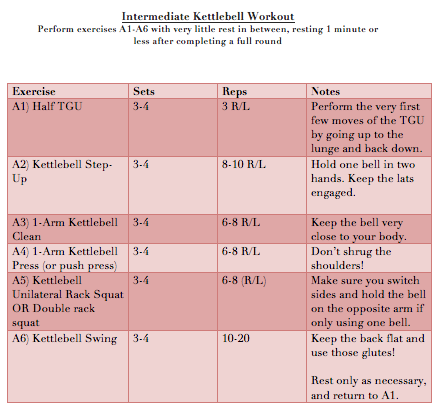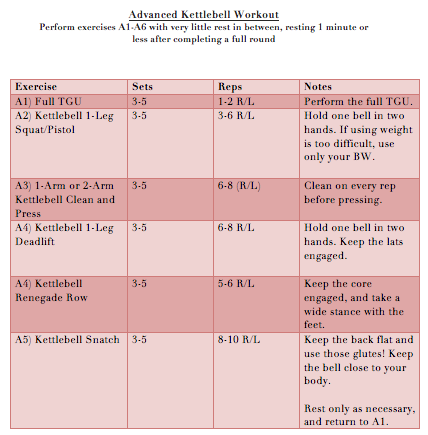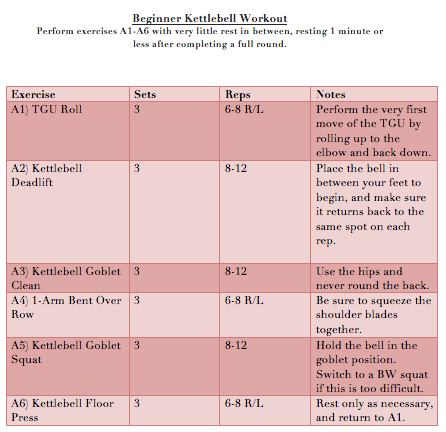Okay, okay. Today I have to swallow my pride and admit that I actually don’t know everything there is to know about exercise. In fact, if my old ways are any indication, the thing I know the most about it how to be a Cardio Queen :- BUT. It’s been a long time since the days to 2+ hours of cardio, and I am happy to report, I am maintaining my weight with 4-5 weight training sessions a week (30 mins or less) and 1 day of sprints per week.
It’s been a fun transition and has let me get waaaaaay more creative in the weight training sphere. I’ve been playing around with CrossFit workouts, traditional bodybuilding splits, Escalating Density Traing (EDT) and metabolic conditioning, including tools I’d never really touched before like power ropes, med balls and yes, kettlebells (hangs head in shame) :)
See, I was always skeptical of kettlebells. I just thought, “Can’t you use a dumbbell to do any movement you’d use a kettlebell for??” Well, more like naive because what I’ve come to find out is … nope, not at all the same effect. And luckily, my good friend Neghar Fonooni, RKC-II certified trainer, was just the person to show me the ropes and help me see just how devastatingly effective kettlebell training can be, as opposed to traditional dumbbell-based workouts.
Good gosh, ARE THEY DIFFERENT!
So I asked Neghar for an Intro to Kettlebells post for JillFit because I though, “Hey, if she can teach me this easily, I think a lot of women would like to get over the fear of using them, too!” And so, here’s a guest post from Neghar, all about how to get started using Kettlebells: Take it away, N! 
Neghar Fonooni, creator of Lean and Lovely
Kettlebells occupy a very special place in my heart.
While I frequently use dumbbells, barbells, medicine balls, battling ropes, and a variety of other tools, it’s the kettlebell that I turn to most frequently, especially if I’m looking for amplified results in a shorter period of time.
Once an obscure, rarely seen or used workout tool, you can now find them in just about any gym, and more and more women are having the opportunity to use them. But, like anything new, figuring out how and why to incorporate them into your exercise routine can be a bit nerve wracking.
I get it. I don’t like new things in general, which is why I almost always order the same thing at my favorite restaurant over and over again, and why I only drink certain types of wine. Change is scary! But adding kettlebells into your fitness regimen is a change that you want to embrace for so many reasons.
Kettlebells Work Your Entire Body At Once
Thanks to the kettlebells unique handle, which creates an offset center of gravity, kettlebell movements require that you significantly activate your stabilizing muscles—even more so than you would with dumbbells and barbells. This makes it ideal for dynamic movements like swings and snatches, and causes your stabilizing muscles to have to work over time, particularly in exercises like presses and Turkish Get Ups.
Most kettlebell movements are dynamic and multi-joint, allowing for total recruitment of the body. Take the kettlebell swing, for example: With just one move you’re working your glutes, quads, abs, lats, and shoulders, all while burning fat and revving your metabolism. Kettlebell training combines stability, flexibility, strength, and cardio, allowing you to simultaneously build muscle and burn body fat.
Kettlebell Workouts Save You Time
The number one excuse I hear for skipping out on exercise is simply “I don’t have time.”
Trust me, I get it. Between being a mom, a wife, and a business owner, I know what it’s like to be ridiculously busy and to feel like there’s no possible way I can fit exercise into the rest of my hustle. But with kettlebells, you do have time, no matter how tight your schedule might be.
Remember, the kettlebell allows you to challenge your core and recruit your entire body at once with just a few moves, which is huge time saver. Rather than spending hours at the gym, you can complete a full body kettlebell workout in as little as 10 minutes. Sounds too good to be true, I know. But with just one moderately sized kettlebell and a few basic exercises, you can complete a total body metabolic resistance workout even when your schedule is jam-packed.
You’ll Work Your Hips Like a Mofo
Ever hear the term “kettlebell booty?” It’s become a bit of a familiar descriptive within the fitness community. That’s because almost every single exercise you can do with a kettlebell involves your hips or glutes in some way. From the swing to the Turkish Get Up, your booty is always in the mix. In order to get the most out of your kettlebell workouts, you want to make sure you can properly hinge at your hips, as well as fully extend them in the standing position—you’ll be doing a lot of both.
KB’s are Versatile and Travel Well
It’s actually kind of insane how much you can get out of just one kettlebell. Of course, as you advance you’ll want to play with a variety of kettlebell weights, but to begin all you need is one. With just a little bit of space to swing it around, you can enjoy an effective, total body, fat-burning workout virtually anywhere. They’re easy to store when not in use, and they travel well too. I’ve taken kettlebells on road trips, to the beach, to the park, and even to friend’s houses for workouts.
Getting Started:
When selecting kettlebell sizes, it is important to ensure that you don’t go too light or too heavy. In order for your workouts to truly be effective, you want the weight to be Goldilocks worthy: Just right. My recommendations for weight are as follows, but if you can only invest in one bell, choose either the light or medium bell from each group:
Beginner:
- Light: (1) 8 kg/18 lbs
- Medium: (2) 10 kg/20 lbs
- Heavy: (1) 12 kg/26 lbs
Intermediate:
- Light: (2) 12 kg/26 lbs
- Medium: (1) 16 kg/36 lbs
- Heavy: (1) 18 or 20 kg/39 or 44 lbs
Advanced:
- Light: (2) 14 kg/31 lbs
- Medium: (1) 18 kg/39 lbs
- Heavy: (1) 24 kg/53 lbs
The most important thing to keep in mind when beginning with kettlebells is this: Technique and quality always trump quantity.
Don’t try advanced exercises like the snatch before you’ve mastered the swing, and furthermore make sue your deadlift is solid before attempting the swing. The thing that makes kettlebells so efficient isn’t the kettlebell at all—it’s you! Your form is clutch when it comes to getting the most out of your workouts, so make sure you spend some time practicing and ensuring that your movements are both safe and effective.
Before attempting the workouts below, make sure you can perform all of the exercises correctly. You’ll want to spend some time practicing the exercises before hand so that you can perform these workouts with intensity and limited rest; that’s what’s going to really allow you to burn fat and rev up your metabolism.
Try to perform each of these exercises back-to-back without resting in between if possible, and break only as long as necessary after completing a full round. But remember, because technique is your first concern, rest as much as needed in order to perform the exercises properly.
Beginner Workout:
(below or right-click to download: BeginnerKettlebells)
Intermediate Workout:

Advanced Workout: That’s it! See how you do and remember, you don’t have to be perfect, and it might feel awkward at first, but just do your best. Keep tight form and remember that you have all the time in the world to master it! Good luck! ~Neghar
That’s it! See how you do and remember, you don’t have to be perfect, and it might feel awkward at first, but just do your best. Keep tight form and remember that you have all the time in the world to master it! Good luck! ~Neghar


